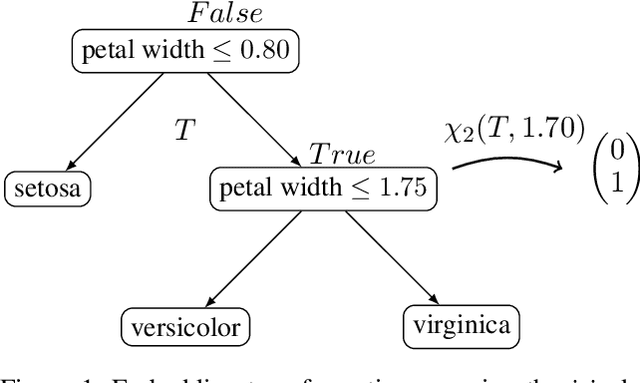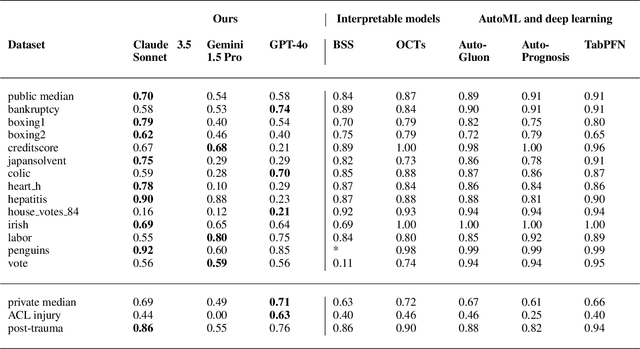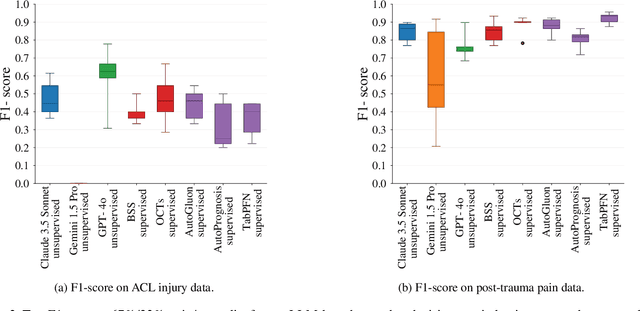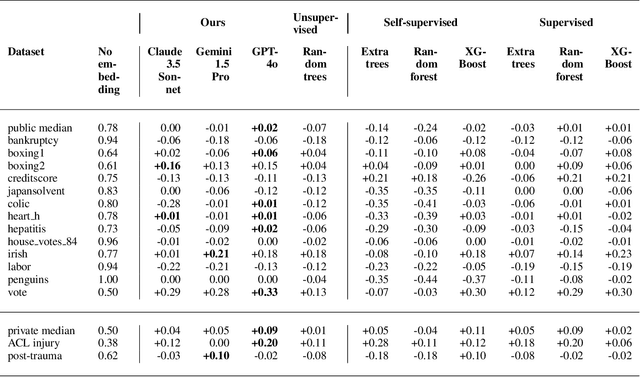Ricardo Knauer
"Oh LLM, I'm Asking Thee, Please Give Me a Decision Tree": Zero-Shot Decision Tree Induction and Embedding with Large Language Models
Sep 27, 2024



Abstract:Large language models (LLMs) provide powerful means to leverage prior knowledge for predictive modeling when data is limited. In this work, we demonstrate how LLMs can use their compressed world knowledge to generate intrinsically interpretable machine learning models, i.e., decision trees, without any training data. We find that these zero-shot decision trees can surpass data-driven trees on some small-sized tabular datasets and that embeddings derived from these trees perform on par with data-driven tree-based embeddings on average. Our knowledge-driven decision tree induction and embedding approaches therefore serve as strong new baselines for data-driven machine learning methods in the low-data regime.
PMLBmini: A Tabular Classification Benchmark Suite for Data-Scarce Applications
Sep 03, 2024



Abstract:In practice, we are often faced with small-sized tabular data. However, current tabular benchmarks are not geared towards data-scarce applications, making it very difficult to derive meaningful conclusions from empirical comparisons. We introduce PMLBmini, a tabular benchmark suite of 44 binary classification datasets with sample sizes $\leq$ 500. We use our suite to thoroughly evaluate current automated machine learning (AutoML) frameworks, off-the-shelf tabular deep neural networks, as well as classical linear models in the low-data regime. Our analysis reveals that state-of-the-art AutoML and deep learning approaches often fail to appreciably outperform even a simple logistic regression baseline, but we also identify scenarios where AutoML and deep learning methods are indeed reasonable to apply. Our benchmark suite, available on https://github.com/RicardoKnauer/TabMini , allows researchers and practitioners to analyze their own methods and challenge their data efficiency.
Squeezing Lemons with Hammers: An Evaluation of AutoML and Tabular Deep Learning for Data-Scarce Classification Applications
May 13, 2024Abstract:Many industry verticals are confronted with small-sized tabular data. In this low-data regime, it is currently unclear whether the best performance can be expected from simple baselines, or more complex machine learning approaches that leverage meta-learning and ensembling. On 44 tabular classification datasets with sample sizes $\leq$ 500, we find that L2-regularized logistic regression performs similar to state-of-the-art automated machine learning (AutoML) frameworks (AutoPrognosis, AutoGluon) and off-the-shelf deep neural networks (TabPFN, HyperFast) on the majority of the benchmark datasets. We therefore recommend to consider logistic regression as the first choice for data-scarce applications with tabular data and provide practitioners with best practices for further method selection.
Cost-Sensitive Best Subset Selection for Logistic Regression: A Mixed-Integer Conic Optimization Perspective
Oct 09, 2023Abstract:A key challenge in machine learning is to design interpretable models that can reduce their inputs to the best subset for making transparent predictions, especially in the clinical domain. In this work, we propose a certifiably optimal feature selection procedure for logistic regression from a mixed-integer conic optimization perspective that can take an auxiliary cost to obtain features into account. Based on an extensive review of the literature, we carefully create a synthetic dataset generator for clinical prognostic model research. This allows us to systematically evaluate different heuristic and optimal cardinality- and budget-constrained feature selection procedures. The analysis shows key limitations of the methods for the low-data regime and when confronted with label noise. Our paper not only provides empirical recommendations for suitable methods and dataset designs, but also paves the way for future research in the area of meta-learning.
 Add to Chrome
Add to Chrome Add to Firefox
Add to Firefox Add to Edge
Add to Edge